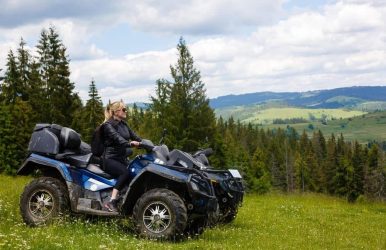Preparing For Spring ATV Riding: 5 Helpful Tips
BY Abdul Aziz MondalApr 12, 2023
It’s almost that time of year. Temperatures are rising, plants are blooming and riders everywhere are getting ready to get back out on the trail. ATV riding season varies based on the location and local climate, but it usually begins shortly before Memorial Day and lasts until mid to late September. But you need to do some prep work before taking your off-road vehicle for a spin. It’s likely been several months since your last adventure, and your vehicle and safety equipment needs to be inspected to make sure it’s safe to ride. Prepare for spring ATV riding with these essential tips: 1. Inspect Your Bike Hopefully, you cleaned off your ATV before you stowed it away for the winter. Excess moisture can lead to rust and other structural damage. Rodents and other pests can also wreak havoc on your equipment. Inspect the vehicle thoroughly for warning signs that it needs to be repaired. Tighten the chain and/or belt, replace any broken wires, and refill/change your fluids, including the oil, transmission, and coolant. Pump the tires and look for weak spots that could leave you stranded with a flat. Cold weather can also damage the battery. Power it on and check the various electrical inputs to make sure it’s working properly. You can also test the power output to see if the battery needs to be replaced. If the vehicle is in need of repair or you’re not sure if it is safe to ride, take it to a mechanic for some peace of mind. 2. Stay Connected [caption id="attachment_9391" align="aligncenter" width="1000"] Source: Locomotive74/Shutterstock.com[/caption] Everyone needs to wear a helmet when riding. Give your safety equipment a once-over as well. Your helmet should still fit and stay securely attached to your head. Some materials can shrink in the cold, which could affect the fit and your comfort level. Inspect the chin strap for damage. And try it on to make sure it still attaches. Watch out for rips or holes in your gloves, boots, and clothing. These items will only last so long before they lose their protective qualities. Stock up on ATV riding gear to get everything you need to stay safe on the trail. Pair your helmet with an off-road communication device to stay connected to the other members of your group. You can communicate hands-free while you focus on navigating uneven terrain. Don’t worry about resetting the device when you fall behind. It will automatically reconnect to your companions when you are in range, so you can keep the conversation going. Use this technology to safely navigate to your destination and avoid using hand signals that can distract you from the task at hand. 3. Find Your Spot [caption id="attachment_9390" align="aligncenter" width="1000"] Source: Vadim Axel/Shutterstock.com[/caption] There are strict limits in terms of where you can ride your ATV. Every state has its own ATV riding laws. You typically don’t need a license to operate the vehicle, but you usually need to be at least 18 years old. Riding on public streets is typically illegal unless you have installed certain safety features, such as lights, mirrors, and a turn signal. Plan your route in advance to make sure you know where you’re going. Contact the park or landowner to find out if it is safe/permissible to ride. You may need a permit in some areas, while others may charge a slight fee. The changing weather can also be a concern. Some trails and roads may still be iced over. There could also be flooding as temperatures continue to rise. Many parts of the country are warming faster than usual, which is causing water levels to rise. Have a paper map of the area on hand and mark your route beforehand to stay prepared. 4. Dress For The Occasion Plan out what you’re going to wear on the trip as well. The temperature can easily go from chilly to warm and back again in a matter of hours. Wear a light moisture-wicking layer that will absorb the sweat so you don’t get drenched during your ride. Keep an extra layer or two on your person in case it starts to get cold again. Keep your skin covered to protect yourself from the sun, trees and pests. You may want to wear a backpack in case you need to change your clothes mid-trip. With spring comes April showers. Have a waterproof jacket on hand to stay dry in the rain. And avoid areas that might be prone to flooding to make sure you can get back the way you came. 5. Prepare For The Unexpected Overall, spring riding means dealing with the unexpected. The weather can change on a dime and excess moisture can make for slick riding conditions. Sudden snowstorms can down trees and render some areas of the trail impassable. Nature is full of surprises, so remember to keep your eyes out for anything unusual. Keep in touch with the landowner or park ranger to stay abreast of any changes in the environment that might affect your trip. Use your wireless headset to communicate with your companions so you can avoid areas that might not be worth the risk. Get Ready To Ride ’Tis the season to get back on your ATV. Use these tips to prepare your vehicle for the ultimate outdoor adventure and make this year’s ATV riding season the best one yet. Additional: 10 Best Places To Travel In March – Travel Guide 2022 15 Best Places For Adventure Dates With Your Loved One Best Kentucky National Parks In the USA You Should Know About










 Latest
Latest




